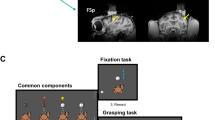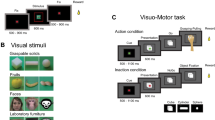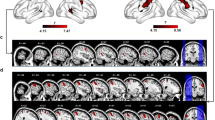Abstract
The ventral pathway is involved in primate visual object recognition. In humans, a central stage in this pathway is an occipito–temporal region termed the lateral occipital complex (LOC), which is preferentially activated by visual objects compared to scrambled images or textures. However, objects have characteristic attributes (such as three-dimensional shape) that can be perceived both visually and haptically. Therefore, object-related brain areas may hold a representation of objects in both modalities. Using fMRI to map object-related brain regions, we found robust and consistent somatosensory activation in the occipito–temporal cortex. This region showed clear preference for objects compared to textures in both modalities. Most somatosensory object-selective voxels overlapped a part of the visual object-related region LOC. Thus, we suggest that neuronal populations in the occipito–temporal cortex may constitute a multimodal object-related network.
This is a preview of subscription content, access via your institution
Access options
Subscribe to this journal
Receive 12 print issues and online access
$209.00 per year
only $17.42 per issue
Buy this article
- Purchase on Springer Link
- Instant access to full article PDF
Prices may be subject to local taxes which are calculated during checkout




Similar content being viewed by others
References
DeYoe, E. & Van Essen D. C. Concurrent processing streams in monkey visual cortex. Trends Neurosci. 115, 219–226 (1988).
Livingstone, M. S. & Hubel, D. E. Segregation of form, color, movement, and depth: anatomy, physiology, and perception. Science 240, 740–749 (1988).
Merigan, W. H. & Maunsell, J. H. How parallel are the primate visual pathways? Annu. Rev. Neurosci. 16, 3180–3191 (1993).
Haxby, J. V. et al. Dissociation of object and spatial visual processing pathways in human extrastriate cortex. Proc. Natl. Acad. Sci. USA 88, 1621–1625 (1991).
Sary, G., Vogels R. & Orban, G. A. Cue-invariant shape selectivity of macaque inferior temporal neurons. Science 260, 995–997 (1993).
Grill-Spector, K. et al. Cue invariant activation in object-related areas of the human occipital lobe. Neuron 21, 191–202 (1998).
Malach, R. et al. Object-related activity revealed by functional magnetic resonance imaging in human occipital cortex. Proc. Natl. Acad. Sci. USA 92, 8135–8139 (1995).
Tootell, R. B. H., Dale, A. M., Sereno, I. & Malach, R. New images from human visual cortex. Trends Neurosci. 19, 481–489 (1996).
Grill-Spector K., Kushnir T., Hendler, T. & Malach R. The dynamics of object-selective activation correlate with recognition performance in humans. Nat. Neurosci . 3, 837–843 (2000).
Kourtzi, Z. & Kanwisher, N. Cortical regions involved in perceiving object shape. J. Neurosci. 20, 3310–3318 (2000).
Talairach, J. & Tournoux, P. Co-planar Stereotaxic Atlas of the Human Brain (Thieme, New York, 1988).
Ishai, A., Ungerleider, L. G. & Haxby, J. H. Distributed neural systems for the generation of visual images. Neuron 28, 979–990 (2000).
Roland, P. E., O'Sullivan, B. & Kawashima, R. Shape and roughness activates different somatosensory areas in the human brain. Proc. Natl. Acad. Sci. USA 95, 3295–3300 (1998).
O'Sullivan, B., Roland, P. E. & Kawashima, R. A PET Study of somatosensory discrimination in man: microgeometry versus macrogeometry. Eur. J. Neurosci. 6, 137–148 (1994).
Tanaka, K. Neuronal mechanisms of object recognition. Science 262, 685–688 (1993).
Tanaka, K. Mechanisms of visual object recognition: monkey and human studies. Curr. Opin. Neurosci. 7, 523–529 (1997).
Desimone, R., Albright, T. D., Gross, C. G. & Bruce, C. Stimulus-selective properties of inferior temporal neurons in the macaque. J. Neurosci. 4, 2051–2061 (1984).
Ito, M., Tamura, H., Fujita, I. & Tanaka, K. Size and position invariance of neuronal responses in monkey inferotemporal cortex. J. Neurophysiol. 73, 218–226 (1995).
Logothetis, N. K., Pauls, J. & Poggio, T. Shape representation in the inferior temporal cortex of monkeys. Curr. Biol. 5, 552–563 (1995).
Logothetis, N. K. & Sheinberg, D. L. Visual object recognition. Annu. Rev. Neurosci. 19, 577–621 (1996).
Saleem, K. S., Suzuki, W., Tanaka, K. & Hashikawa, T. Connections between anterior inferotemporal cortex and superior temporal sulcus regions in the macaque monkey. J. Neurosci. 20, 5083–5101 (2000).
Hikosaka, K., Iwai, E., Saito, H. A. & Tanaka, K. Polysensory properties of neurons in the anterior bank of the caudal superior temporal sulcus of the macaque monkey. J. Neurophysiol. 60, 1615–1637 (1988).
Grill-Spector, K. et al. Differential processing of objects under various viewing conditions in the human lateral occipital complex. Neuron 24, 187–203 (1999).
Sadato, N. et al. Activation of the primary visual cortex by Braille reading in blind subjects. Nature 380, 526–528 (1996).
Cohen, L. G. et al. Functional relevance of cross-modal plasticity in blind humans. Nature 389, 180–183 (1997).
Cavada, C. & Goldman-Rakic, P. C. Posterior parietal cortex in rhesus monkey: II. Evidence for segregated corticocortical networks linking sensory and limbic areas with the frontal lobe. J. Comp. Neurol. 287, 422–445 (1989).
Neal, J. W., Pearson, R. C. & Powell, T. P. The connections of area PG, 7a, with cortex in the parietal, occipital and temporal lobes of the monkey. Brain Res. 532, 249–264 (1990).
Anderson, R. A., Asanuma, C., Essick, G. & Siegel, R. M. Corticocortical connections of anatomically and physiologically defined subdivisions within the inferior parietal lobule. J. Comp. Neurol. 296, 65–113 (1990).
Buonomano, D. V. & Merzenich, M. M. Cortical plasticity: from synapses to maps. Annu. Rev. Neurosci. 21, 149–186 (1998).
Kaas, J. H., Merzenich, M. M. & Killackey, H. P. The reorganization of somatosensory cortex following peripheral nerve damage in adult and developing mammals. Annu. Rev. Neurosci. 6, 325–356 (1983).
Kaas, J. H. Plasticity of sensory and motor maps in adult mammals. Annu. Rev. Neurosci. 14, 137–167 (1991).
Pons, T. P. Reorganization of the brain. Nat. Med. 4, 561–562 (1998).
Pons, T. P., Garraghty, P. E. & Mishkin, M. Lesion-induced plasticity in the second somatosensory cortex of adult macaques. Proc. Natl. Acad. Sci. USA 85, 5279–5281 (1988).
Rauschecker, J. P. Compensatory plasticity and sensory substitution in the cerebral cortex. Trends Neurosci. 18, 36–43 (1995).
Engel, S. A., Glover, G. A. & Wandell, B. A. Retinotopic organization in human visual cortex and the spatial precision of functional MRI. Cereb. Cortex 7, 181–192 (1997).
Serano, S. C. et al. Borders of multiple visual areas in humans revealed by functional magnetic resonance imaging. Science 268, 889–893 (1995).
DeYoe, E. et al. Mapping striate and extrastriate visual areas in human cerebral cortex. Proc. Natl. Acad. Sci. USA 93, 2382–2386 (1996).
Grill-Spector, K. et al. A sequence of object-processing stages revealed by fMRI in the human occipital lobe. Hum. Brain Mapp. 6, 316–328 (1998).
Acknowledgements
We thank M. Harel for the cortex reconstruction, E. Okon for technical assistance and design, and I. Levy for software development. We thank S. Hochstein, G. Avidan-Carmel and U. Hason for their comments. This study was funded by the German-Israeli Foundation for Scientific Research and Development (GIF) grant number I-576-040.01/98 and the Israel Academy of Sciences and Humanities grant 8009/00-1.
Author information
Authors and Affiliations
Corresponding author
Rights and permissions
About this article
Cite this article
Amedi, A., Malach, R., Hendler, T. et al. Visuo-haptic object-related activation in the ventral visual pathway. Nat Neurosci 4, 324–330 (2001). https://doi.org/10.1038/85201
Received:
Accepted:
Issue Date:
DOI: https://doi.org/10.1038/85201
This article is cited by
-
Learning and navigating digitally rendered haptic spatial layouts
npj Science of Learning (2023)
-
Visuo-haptic object perception for robots: an overview
Autonomous Robots (2023)
-
Asymmetric switch cost between subitizing and estimation in tactile modality
Current Psychology (2023)
-
Neural Correlates of Oral Stereognosis—An fMRI Study
Dysphagia (2023)
-
Tactually-related cognitive impairments: sharing of neural substrates across associative tactile agnosia, agraphesthesia, and kinesthetic reading difficulty
Acta Neurologica Belgica (2023)



